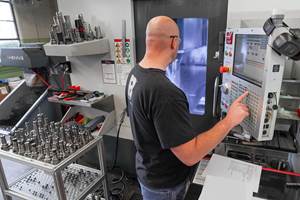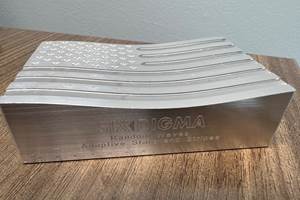Five-Axis Machine/Software Combo Boosts Profitability
After Superior Tool and Mold invested in five-axis machining capacity from Delcam and DMG/Mori Seiki, it realized improved quality and greater profitability.
Share






Established in 1993, Superior Tool and Mold operates from a 15,000-square-foot facility in Ontario, Canada. It specializes in the design and build of injection molds for automotive, industrial and consumer industries. Before switching to five-axis technology, any given part might have required 10 to 15 setups on a conventional three-axis machine. Now, it uses a DMC 125 U duoBlock five-axis machine from DMG/Mori Seiki (Hoffman Estates, Illinois) and five-axis PowerMill capability from Delcam (Windsor, Ontario) to achieve more in a single setup. “It basically comes off the machine as a finished product,” says programmer Andrew Gruening.
Although the shop faced a learning curve when it first implemented five-axis machining, Delcam software enables experienced users to set up templates for less-experienced operators to save time and reduce errors on future programs. Also, full-process computer simulation helps prevent mistakes on the shop floor. “It was a learning curve on the machining, but we had in-depth training through Delcam, and within days we were confident that we could replicate what we were doing in training in the real world,” Mr. Gruening says. “We’re picking up work that we had to turn away,” he says.
Another part of the learning curve for new five-axis users is often adjusting fixturing and workholding strategies. For example, standard workholding devices generally do not enable clear access to multiple sides of the workpiece, whereas specialized five-axis fixtures, chucking mechanisms, and magnetic workholding are designed for that purpose.
The value of continuous five-axis machining is evident in the shop’s ability to use just one machine for three-axis high speed machining, positional five-axis, continuous five-axis, five-axis drilling and more. Five-axis machines also typically provide faster axis travel and spindle speed. Plus, the machines are becoming smaller and more rigid. Other benefits include elimination of blend lines and the ability to continuously maintain proper cutting tool-to-surface orientation. This improves surface finish and tool life. Fewer cutter passes, reduced cycle times and single-setup machining all contribute to time savings, fewer setting errors and better access to undercuts.
Software is crucial to realizing these benefits. A wide range of five-axis strategies are available to improve the manufacturing process, including through a curve, through a point, profiling, automatic calculation of tool position, and gouge and collision checking. In addition, Mr. Gruening says leads and links can be edited to position five-axis transitions in areas of the surface that won’t be visible. “Delcam goes to great lengths to make sure the software is compatible with machine tools that shops have,” Mr. Gruening says. “Right out of the box, we had a perfect post that matched the software to the machine,” he says.
The cost of a five-axis process might be of concern to some shops. According to Delcam, that it is often caused by a lack of understanding of the potential applications of five-axis in a particular market. Once a shop fully understands where benefits can be achieved, reduced operating costs and increased tool life and efficiency can offset the initial investment. Plus, more applications will be open to five-axis machining as the technology improves.
Mr. Gruening says Superior Tool and Mold made the right choice in adopting five-axis capabilities. “We took the initiative to update our company, update our machinery and update all our software, and we are starting to reap the benefits now,” he says.
Related Content
The Power of Practical Demonstrations and Projects
Practical work has served Bridgerland Technical College both in preparing its current students for manufacturing jobs and in appealing to new generations of potential machinists.
Read MoreMedical Shop Performs Lights-Out Production in Five-Axes
Moving to five-axis machining enabled this shop to dramatically reduce setup time and increase lights-out capacity, but success relied on the right combination of workholding and automation.
Read MoreBuilding Machines and Apprenticeships In-House: 5-Axis Live
Universal machines were the main draw of Grob’s 5-Axis Live — though the company’s apprenticeship and support proved equally impressive.
Read MoreHigh RPM Spindles: 5 Advantages for 5-axis CNC Machines
Explore five crucial ways equipping 5-axis CNC machines with Air Turbine Spindles® can achieve the speeds necessary to overcome manufacturing challenges.
Read MoreRead Next
AMRs Are Moving Into Manufacturing: 4 Considerations for Implementation
AMRs can provide a flexible, easy-to-use automation platform so long as manufacturers choose a suitable task and prepare their facilities.
Read MoreMachine Shop MBA
Making Chips and Modern Machine Shop are teaming up for a new podcast series called Machine Shop MBA—designed to help manufacturers measure their success against the industry’s best. Through the lens of the Top Shops benchmarking program, the series explores the KPIs that set high-performing shops apart, from machine utilization and first-pass yield to employee engagement and revenue per employee.
Read More




















